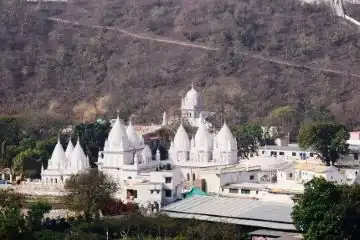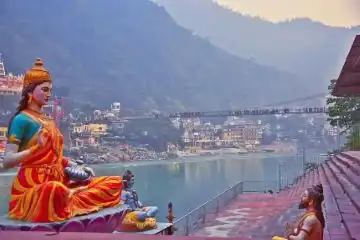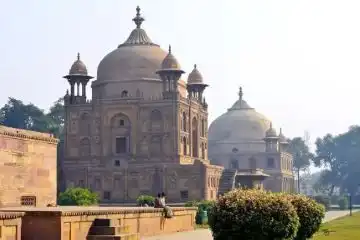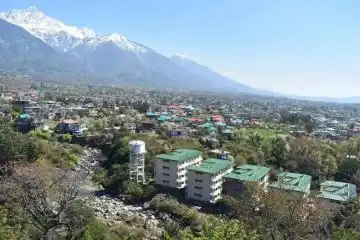The best time to visit Shikharji Weather and crowd Tips
Shikharji, also known as Sammed Shikharji, is one of the most revered Jain pilgrimage sites. For devotees and spiritual seekers alike, choosing the best time to visit Shikharji is essential for a meaningful experience. Shikharji is nestled in the Parasnath Hills of Jharkhand. This holy mountain is believed to be the place where 20 of the 24 Jain Tirthankaras attained moksha (liberation). Weather conditions, crowd sizes, and travel ease all contribute to how fulfilling your journey will be.
In this guide, we explore month-by-month weather trends, peak and off-peak seasons, and practical tips. That will firstly help you to plan the perfect trip. No matter that you're walking the 27 km parikrama route or visiting temples. Understanding the local climate and crowd behavior will further ensure a smooth, serene experience. Visiting the temples and attractions to visit in Deoghar becomes more easy with our travel guides. That are curated to give some highlights about planning the trip.
October to March: The Ideal Season for Visiting Shikharji
If you are seeking the best time to visit Shikharji choose the cooler months between October and March. They are the most favorable months to plan your visit. During this period, the weather is pleasant, with temperatures ranging from 10°C to 25°C. That is meanwhile ideal for long walks and spiritual contemplation.
This season is also free from the discomfort of monsoon rains or summer heat. It's the best time to visit Shikharji for most pilgrims, especially during major Jain festivals. Few are for example Paryushana and Mahavir Jayanti. That may fall in this window depending on the lunar calendar.
Avoiding the Summer Heat: April to June
Summer in the Parasnath Hills can be harsh, with daytime temperatures often exceeding 35°C. Early April may still be manageable for seasoned travelers. There are many tourist places to explore in Shikharji for visitors. But, May and June are best avoided due to scorching heat and dehydration risks.
Walking barefoot on the parikrama trail under the intense sun can be uncomfortable. Even though the area is less crowded, the high temperatures can meanwhile detract from your spiritual journey.
The Monsoon Challenge: July to September
Monsoon brings lush greenery to the hills of Jharkhand. But, it further comes with slippery trails and unpredictable weather. From July to September, the region receives heavy rainfall, which makes trekking difficult and potentially dangerous.
The parikrama becomes muddy, visibility is reduced, and leeches are not uncommon in the forested areas. In addition, frequent rains can cause transportation delays. Unless you are prepared for a rugged adventure, this is not the best time to explore Shikharji.
Weekend vs Weekday Visits: Crowd Management Tips
Shikharji can get crowded, especially on weekends and during public holidays. If you wish to avoid the bustle plan your visit mid-week, preferably Tuesday through Thursday. During these days, you can enjoy a more contemplative experience.
This strategy helps you steer clear of weekend pilgrim buses and school trips. It further allows for a more serene experience during prayers and temple visits.
Festival Season: High Energy, High Footfall
Jain festivals for example Paryushana, Mahavir Jayanti, and Diwali bring thousands of pilgrims to Shikharji. The atmosphere is spiritually charged and lively. But, expect dense crowds, long queues, and full accommodations.
If you want to witness devotional fervor at its peak, visiting during these events can be rewarding. However, if solitude and quiet reflection are your goals, visit just before or after the festival weeks.
Sunrise Treks and Early Starts: Beat the Rush
Regardless of the season, start your trek early in the morning-preferably around 4:00 to 5:00 AM. That is a good way to avoid crowds and midday heat. Mornings are peaceful, and you can witness a breathtaking sunrise from the hilltop temples.
Walking in the early hours also gives you time to complete the 27 km circuit comfortably. Above all, you can rest in between, and still return before evening.
Off-Season Travel: Pros and Cons
The off-season, particularly June to September, may appeal to budget-conscious travelers. During that, hotel rates are lower and the place is less crowded. But keep in mind the challenges: erratic weather, maintenance closures, and limited public transportation options.
Accommodation Booking Tips for Peak Season
The optimal October-March window, lies especially around festivals. If you are planning to visit during that, book your dharamshala or hotel accommodation well in advance. Popular guesthouses near Madhuban (the base village) fill up quickly.
Check reviews for clean bathrooms, availability of Jain meals, and proximity to the starting point of the trek. Having a peaceful place to rest further enhances the overall spiritual experience.
Transportation and Travel Planning Tips
Shikharji is accessible by road and rail, with the nearest major railhead being Parasnath Station. From there, local autos or taxis can take you further to Madhuban, the starting point.
During peak season, trains and buses may be overbooked. Reserve your travel tickets early. If possible, opt for early morning or late-night arrivals to avoid rush-hour chaos.
If you are traveling with elderly family members, consider hiring a doli (palanquin) service. That will help them in the climb. They are available more reliably during peak seasons.
Summary: Choosing the Best Time to Visit Shikharji
The best time to visit Shikharji is undoubtedly between October and March. During that, the weather is pleasant and conducive for trekking, meditation, and worship. Weekdays during this season offer the perfect balance-spiritually enriching and crowd-free.
Avoid the intense summer heat and monsoon hassles unless you're prepared for extreme conditions. Do proper planning, early bookings, mindful packing and choose best time to visit Shikharji. With that, your journey to Shikharji can be as serene and uplifting as it is sacred.
















